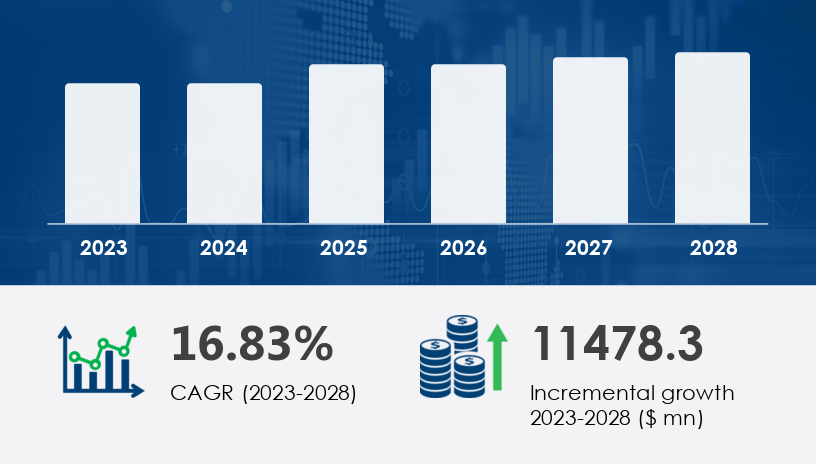Dimethyl Ether Market Poised for Robust Growth Amid Rising Demand for Cleaner Energy Solutions 2024-2028
The dimethyl ether (DME) market is projected to expand by USD 11.47 billion from 2024 to 2028, experiencing a CAGR of 16.83%. Market growth is fueled by the environmental benefits of DME, its cost-effectiveness over liquefied petroleum gas (LPG), and the ample availability of raw materials. The increasing use of Clean Fuels and LPG Blending is further driving demand, particularly in Transportation Fuel and Aerosol Propellants applications. Additionally, DME’s role in Bio-Based Energy and Methanol Production supports its adoption as one of the key Diesel Alternatives in the push for Sustainable Energy solutions. However, challenges persist, including competition from the rising adoption of electric vehicles, volatile methanol prices, and lower efficiency compared to diesel fuels. Despite these hurdles, advancements in Fuel Blending, innovative Emission Solutions, and strategic pricing models are expected to drive industry expansion.

For more details about the industry, get the PDF sample report for free
Market Segmentation and Application Growth
By Application
- LPG Blending: This segment is expected to see significant market share growth, as DME is increasingly used to improve combustion efficiency and reduce emissions.
- Transportation Fuel: DME’s clean-burning properties make it an attractive alternative for diesel and LPG in automotive applications.
- Aerosol Propellant: The chemical’s non-toxic nature is driving its adoption in personal care and industrial applications.
- Others: DME is also utilized in enhanced oil recovery and power generation.
By Source
- Coal: A major feedstock for DME production, especially in regions with abundant coal resources.
- Natural Gas: A key source for cost-effective and environmentally friendly DME production.
- Methanol: A primary raw material, though price fluctuations pose challenges.
- Biomass: An emerging sustainable source, gaining traction due to stricter environmental regulations.
By Region
-
North America
- United States: Increasing government incentives for cleaner fuel adoption and integration into the LPG sector.
- Canada: Growing investments in DME as an alternative to diesel in transportation.
-
Europe
- United Kingdom: Shift towards eco-friendly fuel alternatives supported by regulatory policies.
- Germany: Adoption in automotive and industrial applications as part of sustainability initiatives.
- France: Focus on DME’s role in reducing reliance on traditional fossil fuels.
-
Asia-Pacific
- China: A major producer and consumer, driven by industrial demand and government mandates.
- India: Rapidly growing market due to increasing LPG consumption and energy security concerns.
-
Rest of the World (RoW)
- Argentina: Exploring DME as an alternative fuel in the energy sector.
- Australia: Rising focus on renewable-based DME production.
Key Market Trends
- Emerging Economies Driving Demand – Countries like India, China, and Brazil are increasing DME adoption in LPG blending.
- Automotive Sector Expansion – DME is gaining traction as a clean alternative to diesel and LPG.
- Renewable DME Investments – Companies are focusing on biomass-derived DME for sustainability.
- Government Regulations – Policies in China, India, and the EU promote carbon reduction through DME.
- Technological Advancements – Firms like Linde Plc and Shell plc are enhancing DME production efficiency.
Key Market Drivers
- Abundant Raw Materials – Easy access to natural gas, coal, and biomass ensures steady supply.
- Demand for Clean Energy – Industries prefer low-emission fuels like DME to meet regulations.
- LPG Blending Growth – DME is widely used in cooking and heating applications.
- Petrochemical Industry Usage – DME is crucial as a solvent and propellant.
- Enhanced Oil Recovery (EOR) – DME improves oil extraction efficiency.
Major Market Challenges
- Fluctuating Methanol Prices – Production costs vary due to methanol price instability.
- EV Competition – Rising electric vehicle adoption affects DME’s fuel market.
- Lower Efficiency vs. Diesel – DME has lower energy density, impacting industrial use.
- High Storage Costs – Specialized storage and transport infrastructure increases expenses.
- Regulatory Concerns – Strict handling and safety rules limit expansion.
Market Research Overview
The growing demand for Clean Fuel Alternatives is driving innovation across industries, particularly in LPG Blending and Transportation Fuel applications. As sustainability becomes a core focus, the market is witnessing a shift toward Bio-Based Fuels and Methanol Production, which offer lower emissions and improved efficiency. Meanwhile, Coal-Based Fuels and Natural Gas Feedstocks continue to play a crucial role in energy security and industrial applications. Companies are investing in Sustainable Energy Solutions and Low-Carbon Fuels to align with environmental regulations and consumer preferences. The increasing adoption of Diesel Substitutes is further reshaping fuel markets, particularly in sectors looking for alternatives that balance cost, efficiency, and reduced environmental impact.
Get more details by ordering the complete report
Key Companies in the Dimethyl Ether (Dme) Market
Some of the key companies of the Dimethyl Ether (Dme) Market are as follows:
- Aerosolex
- Akzo Nobel NV
- Grillo Werke AG
- JGC Holdings Corp.
- Linde Plc
- LyondellBasell Industries N.V.
- Mitsubishi Gas Chemical Co. Inc.
- Nouryon
- Oberon Fuels Inc.
- PCC Rokita SA
- S and P Global Inc.
- Shell plc
- The Chemours Co.
- thyssenkrupp AG
- Topsoes AS
- Toyo Engineering Corp.
- Zagros Petrochemical Co.
Research Analysis Overview
Technological advancements in Hydrogen Fuel Cells and Industrial Propellants are accelerating the transition toward cleaner energy sources. The rise of Renewable Energy Sources and Emission Reduction strategies is encouraging industries to adopt Fuel Blending Technology to optimize performance while minimizing environmental impact. The use of Chemical Feedstocks in various industrial processes is gaining traction, particularly in the development of Power Generation Fuels that support grid stability. Furthermore, Green Chemistry principles are guiding new innovations in fuel production, ensuring safer and more sustainable alternatives. As industries continue their Energy Transition, the demand for advanced fuel solutions and low-emission alternatives is expected to rise significantly.